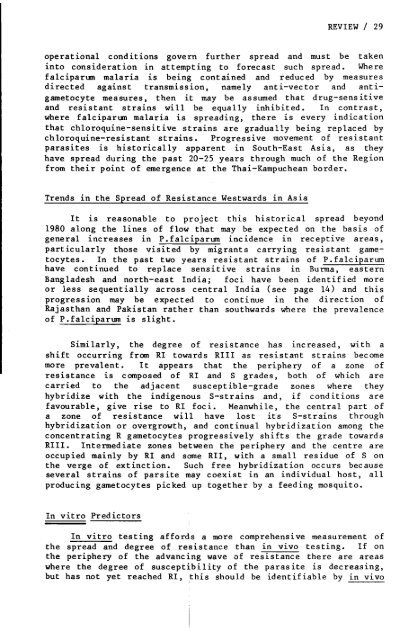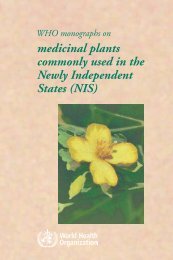Drug-Resistant Malaria - libdoc.who.int - World Health Organization
Drug-Resistant Malaria - libdoc.who.int - World Health Organization
Drug-Resistant Malaria - libdoc.who.int - World Health Organization
You also want an ePaper? Increase the reach of your titles
YUMPU automatically turns print PDFs into web optimized ePapers that Google loves.
REVIEW / 29<br />
operational conditions govern further spread and must be taken<br />
<strong>int</strong>o consideration in attempt ing to forecast such spread. Where<br />
falciparum malaria is being contained and reduced by measures<br />
directed against transmission, namely anti-vector and antigametocyte<br />
measures, then it may be assumed that drug-sensitive<br />
and resistant strains will be equally inhibited. In contrast,<br />
where falciparum malaria is spreading, there is every indication<br />
that chloroquine-sensitive strains are gradually being replaced by<br />
chloroquine-resistant strains. Progressive movement of resistant<br />
parasites is historically apparent in South-East Asia, as they<br />
have spread during the past 20-25 years through much of the Region<br />
from their po<strong>int</strong> of emergence at the Thai-Kampuchean border.<br />
Trends in the Spread of Resistance Westwards in Asia<br />
It is reasonable to project this historical spread beyond<br />
1980 along the lines of flow that may be expected on the basis of<br />
general increases in P. falciparum incidence 1n receptive areas,<br />
particularly those visited by migrants carrying resistant gametocytes.<br />
In the past two years resistant strains of P.falciparum<br />
have continued to replace sensitive strains in Burma, eastern<br />
Bangladesh and north-east India; foci have been identified more<br />
or less sequentially across central India (see page 14) and this<br />
progression may be expected to continue in the direction of<br />
Rajasthan and Pakistan rather than southwards where the prevalence<br />
of P.falciparum is slight.<br />
Similarly, the degree of resistance has increased, with a<br />
shift occurring from RI towards RIll as resistant strains become<br />
more prevalent. It appears that the periphery of a zone of<br />
resistance is composed of RI and S grades, both of which are<br />
carried to the adjacent susceptible-grade zones where they<br />
hybridize with the indigenous S-strains and, if conditions are<br />
favourable, give rise to RI foci. Meanwhile, the central part of<br />
a zone of resistance will have lost its S-strains through<br />
hybridization or overgrowth, and continual hybridization among the<br />
concentrating R gametocytes progressively shifts the grade towards<br />
RIll. Intermediate zones between the periphery and the centre are<br />
occupied mainly by RI and some RII, with a small residue of S on<br />
the verge of extinction. Such free hybridization occurs because<br />
several strains of parsite may coexist in an individual host, all<br />
producing gametocytes picked up together by a feeding mosquito.<br />
In vitro Predictors<br />
In vitro testing affords a more comprehensive measurement of<br />
the spread and degree of resistance than in vivo testing. If on<br />
the periphery of the advancing wave of resistance there are areas<br />
where the degree of susceptibility of the paras ite is decreasing,<br />
but has not yet reached RI,this should be identifiable by in vivo
















